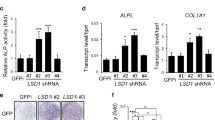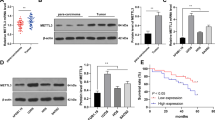Abstract
Osteoblast differentiation is regulated by various transcription factors, signaling molecules, and posttranslational modifiers. The histone acetyltransferase Mof (Kat8) is involved in distinct physiological processes. However, the exact role of Mof in osteoblast differentiation and growth remains unknown. Herein, we demonstrated that Mof expression with histone H4K16 acetylation increased during osteoblast differentiation. Inhibition of Mof by siRNA knockdown or small molecule inhibitor, MG149 which is a potent histone acetyltransferase inhibitor, reduced the expression level and transactivation potential of osteogenic key markers, Runx2 and Osterix, thus inhibiting osteoblast differentiation. Besides, Mof overexpression also enhanced the protein levels of Runx2 and Osterix. Mof could directly bind the promoter region of Runx2/Osterix to potentiate their mRNA levels, possibly through Mof-mediated H4K16ac to facilitate the activation of transcriptional programs. Importantly, Mof physically interacts with Runx2/Osterix for the stimulation of osteoblast differentiation. Yet, Mof knockdown showed indistinguishable effect on cell proliferation or apoptosis in MSCs and preosteoblast cells. Taken together, our results uncover Mof functioning as a novel regulator of osteoblast differentiation via the promotional effects on Runx2/Osterix and rationalize Mof as a potential therapeutic target, like possible application of inhibitor MG149 for the treatment of osteosarcoma or developing specific Mof activator to ameliorate osteoporosis.







Similar content being viewed by others
References
Arnsdorf EJ et al (2010) The epigenetic mechanism of mechanically induced osteogenic differentiation. J Biomech 43(15):2881–2886
Bradley EW et al (2015) Histone deacetylases in bone development and skeletal disorders. Physiol Rev 95(4):1359–1381
Chan WCW, Tan Z, To MKT, Chan D (2021) Regulation and role of transcription factors in osteogenesis. Int J Mol Sci 22:5445
Chen Q et al (2016) Fate decision of mesenchymal stem cells: adipocytes or osteoblasts? Cell Death Differ 23(7):1128–1139
Dao DY et al (2007) Axin1 and Axin2 are regulated by TGF- and mediate cross-talk between TGF- and Wnt signaling pathways. Ann N Y Acad Sci 1116:82–99
Dou Y et al (2005) Physical association and coordinate function of the H3 K4 methyltransferase MLL1 and the H4K16 acetyltransferase MOF. Cell 121(6):873–885
Du JK et al (2020) Osteoblast and osteoclast activity affect bone remodeling upon regulation by mechanical loading-induced leukemia inhibitory factor expression in osteocytes. Front Mol Biosci 7
Fan X et al (2004) Regulation of RANKL promoter activity is associated with histone remodeling in murine bone stromal cells. J Cell Biochem 93(4):807–818
Gupta A et al (2008) The mammalian ortholog of Drosophila MOF that acetylates histone H4 lysine 16 is essential for embryogenesis and oncogenesis. Mol Cell Biol 28(1):397–409
Hajji N et al (2010) Opposing effects of hMOF and SIRT1 on H4K16 acetylation and the sensitivity to the topoisomerase II inhibitor etoposide. Oncogene 29(15):2192–2204
Huynh NC et al (2016) Inhibition of histone deacetylases enhances the osteogenic differentiation of human periodontal ligament cells. J Cell Biochem 117(6):1384–1395
Komori T (2005) Regulation of skeletal development by the Runx family of transcription factors. J Cell Biochem 95(3):445–453
Krishnan V et al (2011) Histone H4 lysine 16 hypoacetylation is associated with defective DNA repair and premature senescence in Zmpste24-deficient mice. P Natl Acad Sci USA 108(30):12325–12330
Li X et al (2012) The histone acetyltransferase MOF is a key regulator of the embryonic stem cell core transcriptional network. Cell Stem Cell 11(2):163–178
Li X et al (2010) MOF and H4K16 acetylation play important roles in DNA damage repair by modulating recruitment of DNA damage repair protein Mdc1. Mol Cell Biol 30(22):5335–5347
Li XZ et al (2009) Two mammalian MOF complexes regulate transcription activation by distinct mechanisms. Mol Cell 36(2):290–301
Lin GL, Hankenson KD (2011) Integration of BMP, Wnt, and notch signaling pathways in osteoblast differentiation. J Cell Biochem 112(12):3491–3501
Lin HP et al (2016) Destabilization of fatty acid synthase by acetylation inhibits de novo lipogenesis and tumor cell growth. Cancer Res 76(23):6924–6936
Luo H et al (2016) MOF acetylates the histone demethylase LSD1 to suppress epithelial-to- mesenchymal transition. Cell Rep 15(12):2665–2678
Maeda K, Kobayashi Y, Koide M, Uehara S, Okamoto M, Ishihara A et al (2019) The regulation of bone metabolism and disorders by Wnt signaling. Int J Mol Sci 20:5255
Niger C et al (2011) The transcriptional activity of osterix requires the recruitment of Sp1 to the osteocalcin proximal promoter. Bone 49(4):683–692
Perez-Campo FM, Riancho JA (2015) Epigenetic mechanisms regulating mesenchymal stem cell differentiation. Curr Genomics 16(6):368–383
Schroeder TM et al (2007) Gene profile analysis of osteoblast genes differentially regulated by histone deacetylase inhibitors. BMC Genomics 8:362
Shen J et al (2002) Transcriptional induction of the osteocalcin gene during osteoblast differentiation involves acetylation of histones H3 and H4. J Bone Miner Res 17:S439–S439
Shahbazian MD, Grunstein M (2007) Functions of site-specific histone acetylation and deacetylation. Annu Rev Biochem 76:75–100
Stein GS et al (2004) Runx2 control of organization, assembly and activity of the regulatory machinery for skeletal gene expression. Oncogene 23(24):4315–4329
Suzuki A, Minamide M, Iwaya C, Ogata K, Iwata J (2020) Role of Metabolism in Bone Development and Homeostasis 21(23):8992
Sykes SM et al (2006) Acetylation of the p53 DNA-binding domain regulates apoptosis induction. Mol Cell 24(6):841–851
Taipale M et al (2005) HMOF histone acetyltransferase is required for histone H4 lysine 16 acetylation in mammalian cells. Mol Cell Biol 25(15):6798–6810
Thomas T et al (2008) Mof (MYST1 or KAT8) is essential for progression of embryonic development past the blastocyst stage and required for normal chromatin architecture. Mol Cell Biol 28(16):5093–5105
Vimalraj S et al (2015) Runx2: structure, function, and phosphorylation in osteoblast differentiation. Int J Biol Macromol 78:202–208
Wang M et al (2021) Lack of MOF decreases susceptibility to hypoxia and promotes multidrug resistance in hepatocellular carcinoma via HIF-1alpha. Front Cell Dev Biol 9:718707
Wei S et al (2021) MOF upregulates the estrogen receptor alpha signaling pathway by its acetylase activity in hepatocellular carcinoma. Cancer Sci 112(5):1865–1877
Wu M, Chen G, Li YP (2016) TGF-beta and BMP signaling in osteoblast, skeletal development, and bone formation, homeostasis and disease. Bone Res 4:16009
Xu XJ et al (2021) SPTBN1 prevents primary osteoporosis by modulating osteoblasts proliferation and differentiation and blood vessels formation in bone. Front Cell Dev Biol 9
Yang D et al (2015) Histone demethylase Utx regulates differentiation and mineralization in osteoblasts. J Cell Biochem 116(11):2628–2636
Zhang P et al (2016) Histone H3K9 acetyltransferase PCAF is essential for osteogenic differentiation through bone morphogenetic protein signaling and may be involved in osteoporosis. Stem Cells 34(9):2332–2341
Zhang R et al (2013) Wnt/beta-catenin signaling activates bone morphogenetic protein 2 expression in osteoblasts. Bone 52(1):145–156
Zhu FC et al (2012) The transcription factor osterix (SP7) regulates BMP6-induced human osteoblast differentiation. J Cell Physiol 227(6):2677–2685
Funding
This work was supported by National Key R&D Program of China 2016YFE0129200, National Natural Science Foundation of China (Nos. 31571321, 81601337) and the Natural Science Foundation of Shandong Province, China (No. ZR2022MH003).
Author information
Authors and Affiliations
Contributions
Conceptualization, X.Z.L. and X.Z.; investigation, J.M.C., D.L., B.C., X.Z., H.Y.Z., and K.L.; methodology, J.M.C., D.L., B.C., Y.Y., D.Y.L., L.N.Z., H.R.L., and M.Q.L.; writing, J.M.C., X.Z., and X.Z.L. All authors have reviewed and approved the manuscript.
Corresponding authors
Ethics declarations
Ethical approval
Not applicable.
Consent to participate
Not applicable.
Conflict of interest
The authors declare no competing interests.
Additional information
Publisher's Note
Springer Nature remains neutral with regard to jurisdictional claims in published maps and institutional affiliations.
Supplementary Information
Below is the link to the electronic supplementary material.
Rights and permissions
Springer Nature or its licensor (e.g. a society or other partner) holds exclusive rights to this article under a publishing agreement with the author(s) or other rightsholder(s); author self-archiving of the accepted manuscript version of this article is solely governed by the terms of such publishing agreement and applicable law.
About this article
Cite this article
Chen, J., Liu, D., Chen, B. et al. The histone acetyltransferase Mof regulates Runx2 and Osterix for osteoblast differentiation. Cell Tissue Res 393, 265–279 (2023). https://doi.org/10.1007/s00441-023-03791-5
Received:
Accepted:
Published:
Issue Date:
DOI: https://doi.org/10.1007/s00441-023-03791-5




